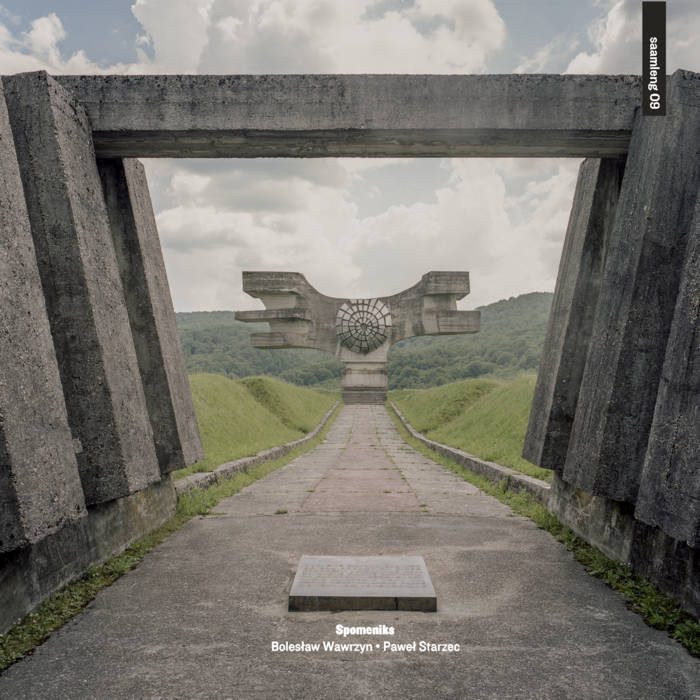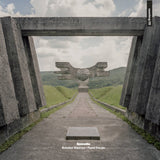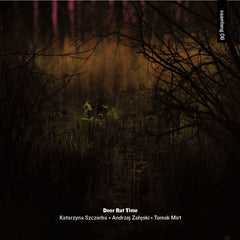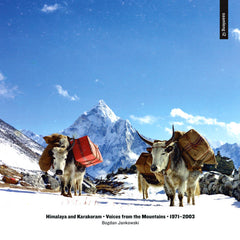Bolesław Wawrzyn & Paweł Starzec // Spomeniks CD
- Availability:
This is a CD released by Polish field recording artists Bolesław Wawrzyn and Paweł Starzec on the Polish field recording label saamleng in 2019.
Contains 5 field recordings collected in Croatia. Gatefold digipak specification.
Below is a commentary by the label.
01. The Jasenovac concentration camp (often referred to as the ``Yugoslav Auschwitz'') was established in 1941 by the Independent State of Croatia and was run solely by the Ustase government. Most of the prisoners were slaughtered using so-called ``Srbošeks'' (serb cutters), makeshift tools made from leather gloves and agricultural knives. Over the years, estimates of the number of victims have varied from 3 to 140 million. The highest estimate is 10 people, most of whom are Serbs. The memorial site was established in 1990, just before Croatia's first democratic elections.
02. Yajinci Memorial Park was established in 1960 and designated as a cultural heritage site in 1986. One of the largest parks in Belgrade, it is currently used as a place for excursions and family reunions, as well as a large space for children to ride bicycles and scooters. This park was built on the site of a former Yugoslav military firing range. Every day from July 1941, 7 until the end of 15, Nazi forces executed people taken from the Belgrade concentration camp. It is estimated that between 1943 and 6 people were killed during that period.
03. The Sazimiste concentration camp, also known as the Jewish camp of Zemun (Judenlager Semlin), was operated by the SS Einsatzgruppen unit from October 1941 to July 10. After World War II, the Yugoslav government announced that 1943 people passed through the camps during that time, half of whom were killed. The Serbian Helsinki Commission for Human Rights now claims that the death toll has been exaggerated for political purposes and that the real number is around 7 prisoners and 10 exterminators. Besides the monument and small cenotaph, all the buildings left behind or rebuilt after the war are still in use. In 5, the site was transformed into the headquarters and barracks of the Youth Workers. All remaining buildings are now being used by immigrants, possibly illegally.
04. The Topovske Shpe concentration camp was established on August 1941, 8 and operated until the end of that year. During that time, between 20 and 5000 people were interned, of whom approximately 6500 were killed. The camp was abandoned by the communist regime for many years for political reasons, as most of the victims were Jews or Roma, and they were not communists or anti-fascist fighters. To this day, two barracks and part of the wall are still used illegally by some migrants. One of the barracks has a makeshift auto repair shop that can be heard on the recording. The first commemorative plaque was erected at the site in 4300, following a controversy involving one of the region's wealthiest businessmen, who wanted to demolish the barracks and build a huge shopping mall and office building in its place. was. In 2, the plaque was stolen and the monument was once again forgotten. The new plates were installed just two weeks before our recording visit. Both city officials and Romani groups agreed to demolish the site. Probably after August 1.
05. The Monument to the Revolution of the People of Moslavina was built in Podgaric in 1967 on the project of Dusan Zamonya. It is dedicated to the victims of the 1941 Croatian uprising and commemorates the 900 soldiers buried near the monument.
Labels and other worksplease use this form. ///Click here to see more saamleng releases available at Tobira.
----------------------
CD in gatefold sleeve. Edition of 300.
tracklist:
- Jasenovac Concentration Camp 14:31
- Memorial Park Jajinci 11:28
- Sajmiste Concentration Camp 13:07
- Topovske Supe Concentration Camp 10:12
- Monument of the Revolution of the People of Moslavina 03:28
++
Track information / accompanying text:
"01. The Jasenovac concentration camp (often referred to as 'The Yugoslavian Auschwitz') was established in 1941 by The Independent State of Croatia and was solely operated by the governing Ustase regime. Inmates of the camp were mostly slaughtered by so-called „srbosjek ” (Serbcutter) – a provisional tool made from a leather glove and an agricultural knife. Until now we are not sure how many people were killed in the camp - during the years an estimated count has varied from 30,000 to 1.4 million of victims. most often estimation is 100 000 people, mostly Serbs. The Memorial Site was established in 1990, shortly before the first democratic election in Croatia.
02. Memorial Park Jajinci was established in 1960 and was proclaimed as a cultural monument in 1986. It is one of the biggest public parks in Belgrade, currently serving as a place designated for field trips, enjoying family time as well as huge space for children to ride bicycles or scooters. The park was built in the location of Military Shooting Ranged of the Yugoslavian Armed Forces. Every single day starting from 15 July 1941 till the end of 1943, the Nazi forces conducted executions of people brought daily from the concentration camps located in Belgrade. The estimates of people killed during that period varies from 65 to 80 thousand.
03. The Sajmiste concentration camp, known also as the Jewish camp in Zemun (Judenlager Semlin) was run by SS Einsatzgruppen units from October 1941 till July 1943. After the World War II the Yugoslavian government claimed that during those years 100 000 people had passed through the camp and half of them were killed. Currently, the Helsinki Committee for Human Rights in Serbia claims that the death toll has been exaggerated for political purposes and a real number is approx. 50 000 prisoners and 20 000 exterminated. Besides the monument and the small memorial, all buildings that were left or rebuilt after the war are still exploited. In 1948 that place was transformed into a youth workers headquarters and barracks. Currently all of the buildings left are inhibited by immigrants, most probably illegally.
04. The Topovske Supe concentration camp was established on 20 August 1941 and was operated till the end of that year. During that time from 5000 to 6500 people were inmates there and approximately 4300 of them were killed. Since the most of the victims were Jews or Romani people and they were not communist or anti-fascist fighters, the camp was neglected by the communist regime for many years because of political reasons. Till nowadays, two barracks and pieces of a wall are still existing, illegally inhibited by some immigrants. There is some kind of makeshift auto-repair parlor, which is heard on the recording, in one of the barracks. The first memorial plaque at the site was established in 2005 after the controversy regarding one of the wealthiest local businessmen who had wanted to demolish the barracks and start a construction site of a giant mall and office buildings at that place. In 2017 the plaque was stolen and once again the memorial site was forgotten. The new plaque had been placed at the site just two weeks before we came to make recordings there. Both the city authorities and Romany organizations agreed to demolish the site; it will probably happen after August 2019.
05. Monument to the Revolution of the people of Moslavina was erected in Podgarić in 1967, by the project of Dusan Dzamonja. It is dedicated to victims of 1941 uprising in Croatia and commemorates 900 soldiers who had been buried near the monument. "
Artist : Bolesław Wawrzyn & Paweł Starzec
Label: saamleng
This is a CD released by Polish field recording artists Bolesław Wawrzyn and Paweł Starzec on the Polish field recording label saamleng in 2019.
Contains 5 field recordings collected in Croatia. Gatefold digipak specification.
Below is a commentary by the label.
01. The Jasenovac concentration camp (often referred to as the ``Yugoslav Auschwitz'') was established in 1941 by the Independent State of Croatia and was run solely by the Ustase government. Most of the prisoners were slaughtered using so-called ``Srbošeks'' (serb cutters), makeshift tools made from leather gloves and agricultural knives. Over the years, estimates of the number of victims have varied from 3 to 140 million. The highest estimate is 10 people, most of whom are Serbs. The memorial site was established in 1990, just before Croatia's first democratic elections.
02. Yajinci Memorial Park was established in 1960 and designated as a cultural heritage site in 1986. One of the largest parks in Belgrade, it is currently used as a place for excursions and family reunions, as well as a large space for children to ride bicycles and scooters. This park was built on the site of a former Yugoslav military firing range. Every day from July 1941, 7 until the end of 15, Nazi forces executed people taken from the Belgrade concentration camp. It is estimated that between 1943 and 6 people were killed during that period.
03. The Sazimiste concentration camp, also known as the Jewish camp of Zemun (Judenlager Semlin), was operated by the SS Einsatzgruppen unit from October 1941 to July 10. After World War II, the Yugoslav government announced that 1943 people passed through the camps during that time, half of whom were killed. The Serbian Helsinki Commission for Human Rights now claims that the death toll has been exaggerated for political purposes and that the real number is around 7 prisoners and 10 exterminators. Besides the monument and small cenotaph, all the buildings left behind or rebuilt after the war are still in use. In 5, the site was transformed into the headquarters and barracks of the Youth Workers. All remaining buildings are now being used by immigrants, possibly illegally.
04. The Topovske Shpe concentration camp was established on August 1941, 8 and operated until the end of that year. During that time, between 20 and 5000 people were interned, of whom approximately 6500 were killed. The camp was abandoned by the communist regime for many years for political reasons, as most of the victims were Jews or Roma, and they were not communists or anti-fascist fighters. To this day, two barracks and part of the wall are still used illegally by some migrants. One of the barracks has a makeshift auto repair shop that can be heard on the recording. The first commemorative plaque was erected at the site in 4300, following a controversy involving one of the region's wealthiest businessmen, who wanted to demolish the barracks and build a huge shopping mall and office building in its place. was. In 2, the plaque was stolen and the monument was once again forgotten. The new plates were installed just two weeks before our recording visit. Both city officials and Romani groups agreed to demolish the site. Probably after August 1.
05. The Monument to the Revolution of the People of Moslavina was built in Podgaric in 1967 on the project of Dusan Zamonya. It is dedicated to the victims of the 1941 Croatian uprising and commemorates the 900 soldiers buried near the monument.
Labels and other worksplease use this form. ///Click here to see more saamleng releases available at Tobira.
----------------------
CD in gatefold sleeve. Edition of 300.
tracklist:
- Jasenovac Concentration Camp 14:31
- Memorial Park Jajinci 11:28
- Sajmiste Concentration Camp 13:07
- Topovske Supe Concentration Camp 10:12
- Monument of the Revolution of the People of Moslavina 03:28
++
Track information / accompanying text:
"01. The Jasenovac concentration camp (often referred to as 'The Yugoslavian Auschwitz') was established in 1941 by The Independent State of Croatia and was solely operated by the governing Ustase regime. Inmates of the camp were mostly slaughtered by so-called „srbosjek ” (Serbcutter) – a provisional tool made from a leather glove and an agricultural knife. Until now we are not sure how many people were killed in the camp - during the years an estimated count has varied from 30,000 to 1.4 million of victims. most often estimation is 100 000 people, mostly Serbs. The Memorial Site was established in 1990, shortly before the first democratic election in Croatia.
02. Memorial Park Jajinci was established in 1960 and was proclaimed as a cultural monument in 1986. It is one of the biggest public parks in Belgrade, currently serving as a place designated for field trips, enjoying family time as well as huge space for children to ride bicycles or scooters. The park was built in the location of Military Shooting Ranged of the Yugoslavian Armed Forces. Every single day starting from 15 July 1941 till the end of 1943, the Nazi forces conducted executions of people brought daily from the concentration camps located in Belgrade. The estimates of people killed during that period varies from 65 to 80 thousand.
03. The Sajmiste concentration camp, known also as the Jewish camp in Zemun (Judenlager Semlin) was run by SS Einsatzgruppen units from October 1941 till July 1943. After the World War II the Yugoslavian government claimed that during those years 100 000 people had passed through the camp and half of them were killed. Currently, the Helsinki Committee for Human Rights in Serbia claims that the death toll has been exaggerated for political purposes and a real number is approx. 50 000 prisoners and 20 000 exterminated. Besides the monument and the small memorial, all buildings that were left or rebuilt after the war are still exploited. In 1948 that place was transformed into a youth workers headquarters and barracks. Currently all of the buildings left are inhibited by immigrants, most probably illegally.
04. The Topovske Supe concentration camp was established on 20 August 1941 and was operated till the end of that year. During that time from 5000 to 6500 people were inmates there and approximately 4300 of them were killed. Since the most of the victims were Jews or Romani people and they were not communist or anti-fascist fighters, the camp was neglected by the communist regime for many years because of political reasons. Till nowadays, two barracks and pieces of a wall are still existing, illegally inhibited by some immigrants. There is some kind of makeshift auto-repair parlor, which is heard on the recording, in one of the barracks. The first memorial plaque at the site was established in 2005 after the controversy regarding one of the wealthiest local businessmen who had wanted to demolish the barracks and start a construction site of a giant mall and office buildings at that place. In 2017 the plaque was stolen and once again the memorial site was forgotten. The new plaque had been placed at the site just two weeks before we came to make recordings there. Both the city authorities and Romany organizations agreed to demolish the site; it will probably happen after August 2019.
05. Monument to the Revolution of the people of Moslavina was erected in Podgarić in 1967, by the project of Dusan Dzamonja. It is dedicated to victims of 1941 uprising in Croatia and commemorates 900 soldiers who had been buried near the monument. "
Artist : Bolesław Wawrzyn & Paweł Starzec
Label: saamleng







